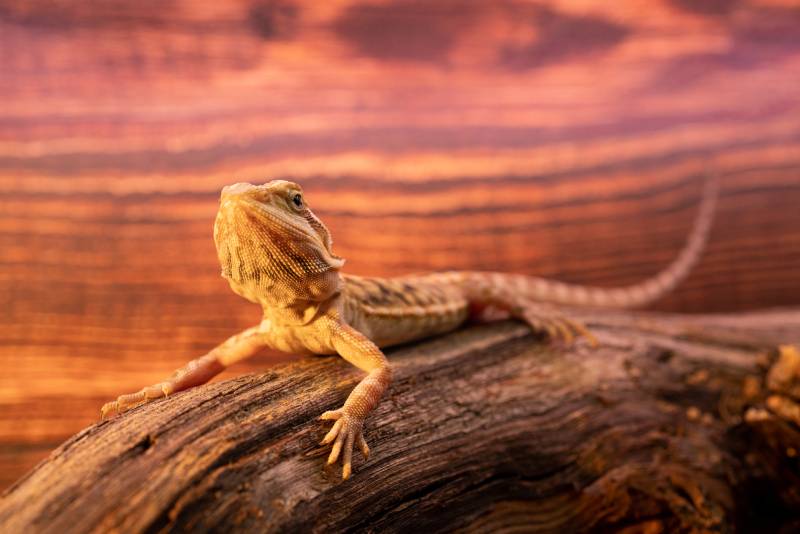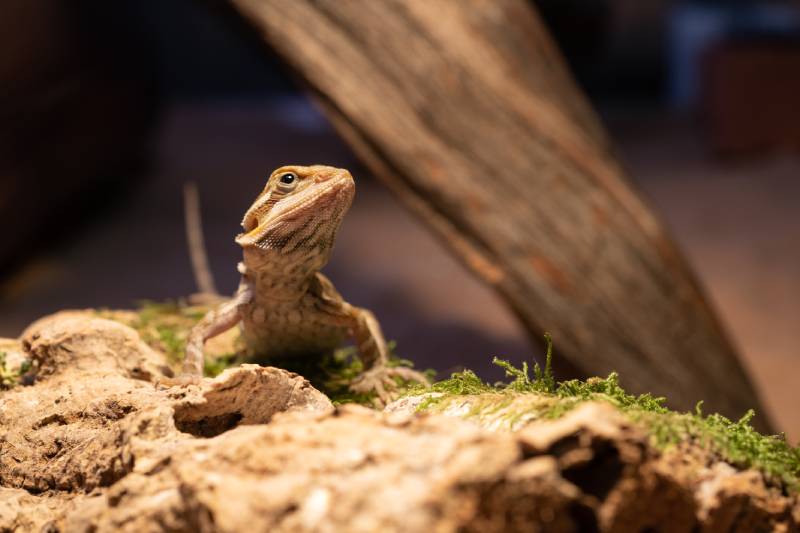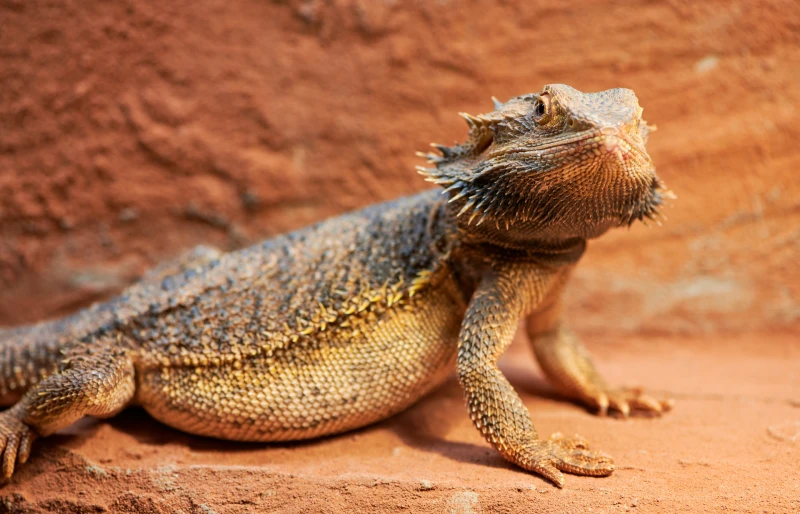Translucent Bearded Dragon: Size, Pictures, Habitat, & Care Guide
Updated on

Most reptile lovers have heard of a bearded dragon. In fact, these lizards are one of the most popular lizards in the pet world.
However, the Translucent Bearded Dragon is much rarer and harder to find. Despite the name, these bearded dragons aren’t actually translucent. Instead, they have translucent scales and spikes, which is the result of selective breeding. They have clear nails and are much lighter in color than other bearded dragons.
They can be interesting bearded dragons to own. For the most part, they act just like any other bearded dragon. However, they are a much rarer color and often cost quite a bit more.
Navigate our complete guide by clicking on the title you would like to review first:
- Quick Facts
- Appearance
- Are They Good Pets?
- How to Take Care
- Feeding
- Shedding
- Health Advice
- Cost
- Care Guide Summary
Quick Facts about the Translucent Bearded Dragon
| Species Name: | Pogona vitticeps |
| Common Name: | Bearded dragon |
| Care Level: | Moderate |
| Lifespan: | 10–15 years |
| Adult Size: | 16–24 inches |
| Diet: | Omnivorous |
| Minimum Tank Size: | 4 feet x 2 feet x 2 feet |
| Temperature & Humidity: | 75–85 ˚ F (cool zone), 88–100 ˚ F (basking area); 20–40% humidity |
Appearance
Translucent Bearded Dragons are a bit different than your usual bearded dragon. As their name suggests, they have translucent scales and spikes. However, they aren’t completely see-through (like some frog species). They have dark eyes with no discernible iris—just like all other bearded dragons.
Often their nails are clear, and they’re typically lighter in color than other bearded dragons. Some can be quite vibrant, though. Their coloring can vary a lot from animal to animal.
These bearded dragons sometimes have blue-colored bellies when they are very young. However, they often dissipate as they become adults. Sometimes, their eyelids are blue, too.
Do Translucent Bearded Dragons Make Good Pets?
Bearded dragons are one of the easier lizards to keep as pets, and the Translucent Bearded Dragon is no different. These reptiles are more social and friendlier than many. They’re much easier to interact with than other lizards, especially if they are adopted from a good breeder.
With that said, they do have specific husbandry needs that must be met for them to thrive. They aren’t like dogs and cats, which have adapted to live with humans. Bearded dragons need specific habitat, lighting, and heating needs. However, they do tend to be more forgiving than other reptiles, making them a good choice for beginners.
As always, be sure you can meet these unique lizards’ needs before adopting one.

Are Translucent Bearded Dragon Friendly? Our Handling Advice
Bearded dragons can be tamed with some ease. They do need to be handled from an early age to accept human handling. However, when socialized properly, they can be fun to interact with. You do need to ensure you meet their specific husbandry needs, though. Otherwise, they can be sickly and aggressive.
Translucent Bearded Dragons are not more aggressive or timid than any other variant. Of course, the individual personality of bearded dragons can vary. Choosing a good breeder is vital, as temperament is somewhat genetic.
How to Take Care of a Translucent Bearded Dragon
Habitat, Tank Conditions & Setup
Tank
Translucent Bearded Dragons have the same needs as other bearded dragons when it comes to their environment. Their tank needs to be at least 4 feet by 2 feet by 2 feet. Smaller, younger beardies can be kept in slightly smaller tanks, but it does need to be upgraded as they age. Bigger is often better, as well.
The tank needs to be big enough to have a “cool zone” and a basking area, allowing your lizard to regulate their body temperature.
You’ll need to keep their tank cleaned. Always remove the bearded dragon when you’re cleaning the tank, placing them into a safe container while you’re cleaning. Use a non-toxic cleaning agent, like vinegar and water, or a reptile-safe disinfectant from the pet store. Always rinse well before placing the dragon back into the tank.

Lighting
Translucent Bearded Dragons need at least 12 hours of UVB light exposure a day. This light is absolutely necessary for their health; otherwise, they cannot produce vitamin D3. Without this light, bearded dragons will develop metabolic bone disease.
UVB light isn’t the same as a heat lamp or other lighting—though many heat lamps do include a UVB bulb, too (it’s usually the small one). You can use a florescent tube to provide UVB lighting across the whole tank, or you can ensure that the heat lamp also includes a UVB light. You’ll need to replace the UVB bulb every 6–12 months, as the output will decrease over time.
You’ll need to include a heating lamp with a white incandescent bulb or a halogen bulb, as well. If you want to provide nighttime lighting, be sure to use a red or blue light. Otherwise, your bearded dragon won’t recognize night from day.
Heating (Temperature & Humidity)
Translucent Bearded Dragons cannot control their own body heat. Therefore, they must have heating provided—just like in the wild.
They need a daytime temperature of about 75 °F to 85 °F. At night, the temperature should drop from 70 °F to 75 °F. The basking area should be warmer than the ambient temperature in the tank—preferably around 88 °F to 100 °F. You should use a thermostat to carefully watch the temperature. Guessing isn’t good enough here.
Bearded dragons need a humidity level of 20% to 40%. This may be the ambient humidity of your home, depending on where you live. Levels outside of this range can lead to shedding and respiratory problems. You should have a hygrometer in your tank to measure the humidity appropriately.
You can lower the humidity by increasing ventilation, changing the substrate, or adding a dehumidifier near the tank. Raising the humidity can be done by misting the tank, adding a humidifier, or adding live plants.

Substrate
Unlike most lizards, the substrate isn’t a huge decision for bearded dragons. These lizards are used to living in the desert. However, sand can cause impaction if your lizard accidentally eats it. Many lizard owners use a “reptile carpet,” which is a synthetic turf that you can easily change out regularly. You can even use newspapers or paper towels for your bearded dragon—as long as your beardie doesn’t try to eat them.
They also make “sandpaper” for bearded dragons, which tries to mimic the desert floor without being easy for them to eat.
Tank Recommendations
| Tank Type | Glass terrarium with mesh lid |
| Lighting | Basking light with UVB; other heating lamps as necessary |
| Heating | Provided by light |
| Best Substrate | Reptile carpet, newspaper, or paper towels |
Feeding Your Translucent Bearded Dragon
Translucent Bearded Dragons have the same diet as any other bearded dragon. They are omnivorous, which means they eat both plants and animals. The ratio of insects to plants depends on the age of your beardie. Younger bearded dragons need more protein, so they often consume more insects.
For younger dragons, about 70% of their diet should be insects. However, for adults, this drops down to about 30%.
You can feed your beardie a range of different insects.
- Crickets
- Dubia roaches
- Earthworms
- Silkworms
- Cockroaches
There are also several insects you should avoid, largely because they’re harder for bearded dragons to digest:
- Fireflies
- Superworms
- Mealworms
- Butterflies
- Moths
Dust the insects with a calcium and vitamin supplement. Captive beardies often don’t consume enough calcium, which leads to health problems.
After feeding insects, you should also offer veggies. However, not all veggies work.
- Carrots
- Zucchini
- Cabbage
- Bell peppers
- Squash
- Broccoli
- Celery
- Cucumbers
- Kale
- Pumpkins
| Diet Summary | |
| Fruits: | Treats only |
| Insects: | 30% for adults (70% for juveniles) |
| Vegetables: | 70% for adults (30% for juveniles) |
| Supplements Required: | Calcium |

Shedding & Brumation: What to Expect
Brumation is a period of dormancy that bearded dragons experience in the colder months. In captivity, this period doesn’t necessarily occur unless the owner makes it occur (usually for breeding purposes). Brumation isn’t necessarily dangerous as long as the bearded dragon is well taken care of.
When in brumation, the bearded dragon won’t be very active and may eat very little. The bearded dragon will sleep for much of the time, though they may occasionally drink water or bask.
Bearded dragons also shed regularly, especially when they are younger. During shedding, the bearded dragon will look obviously dull and patchy. They may be more irritable than usual, as well. The lizard may scratch their body against things to help remove the skin. Shedding isn’t harmful, but it can be uncomfortable.
Keeping Your Translucent Bearded Dragon Healthy
Bearded dragons often stay healthy as long as they’re kept in an appropriate environment. Having the proper lighting, heating, and diet plays a huge role in their health. Always monitor your bearded dragon’s tank conditions to stop problems before they occur.
Even with the best tank setup, bearded dragons can still get sick. Therefore, it’s important to have the contact information for an exotic vet near you.
Common Health Problems
- Metabolic bone disease (MBD): This is a condition caused by a lack of calcium, vitamin D3, or UVB light in the diet or environment. It affects the bones and muscles of the bearded dragon, causing weakness, deformities, fractures, paralysis, and even death. To prevent MBD, you should provide your bearded dragon with a balanced diet that includes calcium-rich insects and plants, as well as a calcium and vitamin D3 supplement.
- Mouth rot (infectious stomatitis): This is a bacterial infection that affects the mouth and gums of the bearded dragon. It causes inflammation, swelling, bleeding, pus, and bad breath. It can also spread to other organs and cause systemic infection. Preventing mouth rot largely consists of keeping their tank clean.
- Parasites: Parasites can cause weight loss, diarrhea, dehydration, anemia, and other complications. Some common parasites that affect bearded dragons are mites, ticks, pinworms, coccidia, giardia, and cryptosporidium.
Lifespan
Translucent Bearded Dragons have the same lifespan as any other bearded dragon—around 10 to 15 years. In captivity, the average is around 10, but some can live up to 15 when well cared for. Of course, all of this assumes that the bearded dragon is being cared for properly.
Sadly, many bearded dragons die before they turn 5 due to poor living conditions. These lizards have many specific housing needs and if they aren’t met, then they may pass before they turn 5.
Breeding
Bearded dragons reach sexual maturity at around 1–2 years old. The right conditions must be provided to make the bearded dragons believe it is spring. Often, temperature and lighting changes instigate this change.
The dragons must be introduced to each other slowly to ensure they are a good match. Sometimes, this can result in serious injuries if done incorrectly.
Once the mating occurs, you’ll need to provide a lay box for the female. She can lay multiple clutches of eggs during the few months after mating. The eggs must be incubated in a separate container with the correct humidity and temperature levels. If done correctly, it takes about 60–80 days.
How Much Do Translucent Bearded Dragons Cost?
Translucent Bearded Dragons are rarer than other bearded dragons, so you often have to pay more for them. You may pay anywhere from $250 to $1,500 for a Translucent Bearded Dragon, depending on where you purchase it from.
It’s often best to purchase them from a breeder (for health reasons). However, this can also be the most expensive option.
Care Guide Summary
- Unique appearance
- Friendly personality
- Same care requirements as other bearded dragons
- More expensive
- More likely to have genetic issues
- More sensitive to UVB light and heat
Conclusion
Translucent Breaded Dragons are a unique morph that’s paler than other bearded dragons. Their spines and scales are often translucent, but that doesn’t make them completely see-through.
While their color is unique, they require the same care as other bearded dragons. You’ll need to set up their cage appropriately to ensure that they’re well cared for. When cared for properly, they can be fun and friendly companions.
See also:
- Red Bearded Dragon: Size, Pictures, Habitat & Care Guide
- Orange Bearded Dragon: Facts, Care, Diet & Health (with Pictures)
Featured Image Credit: Tenshi, Shutterstock











